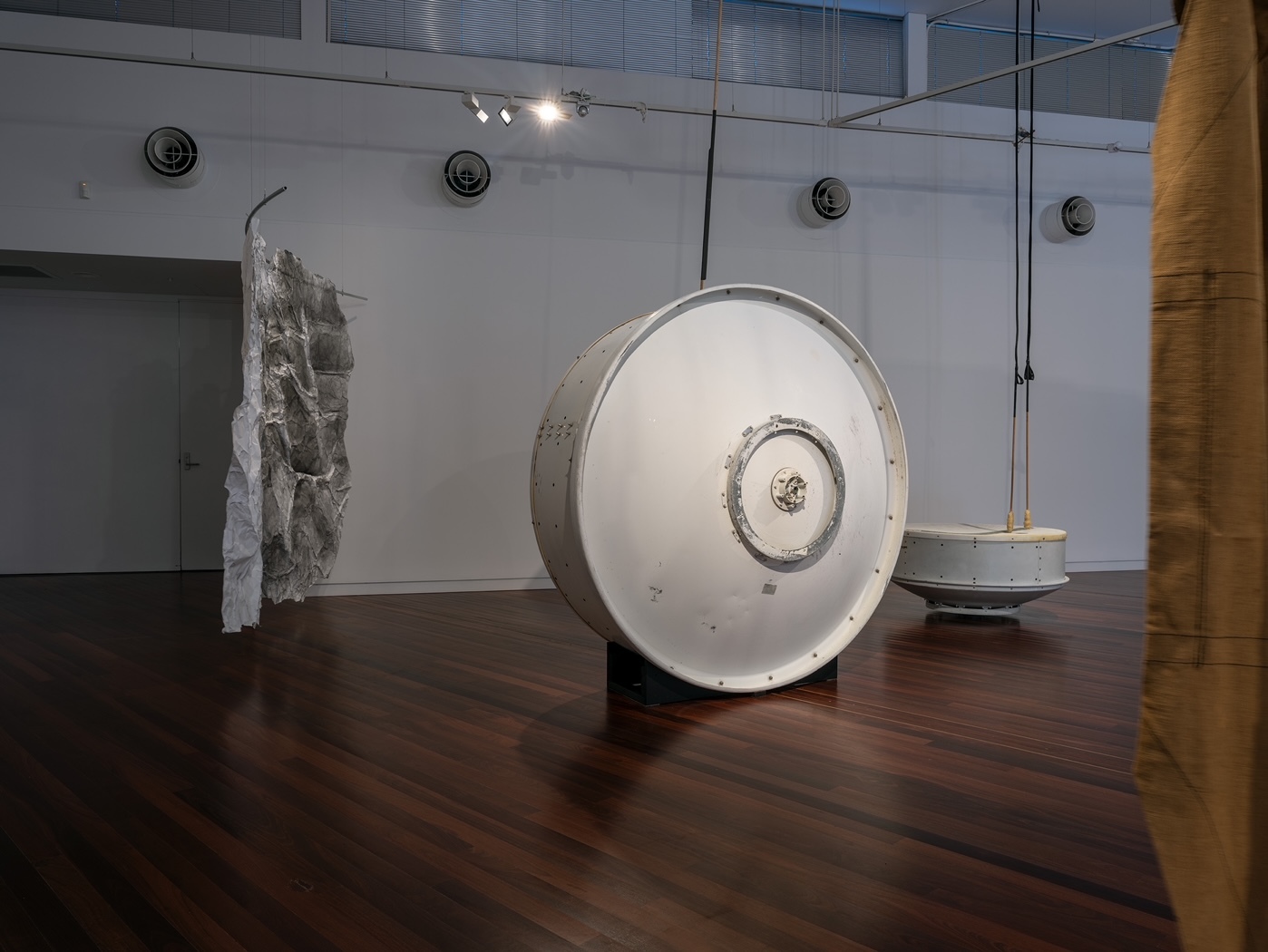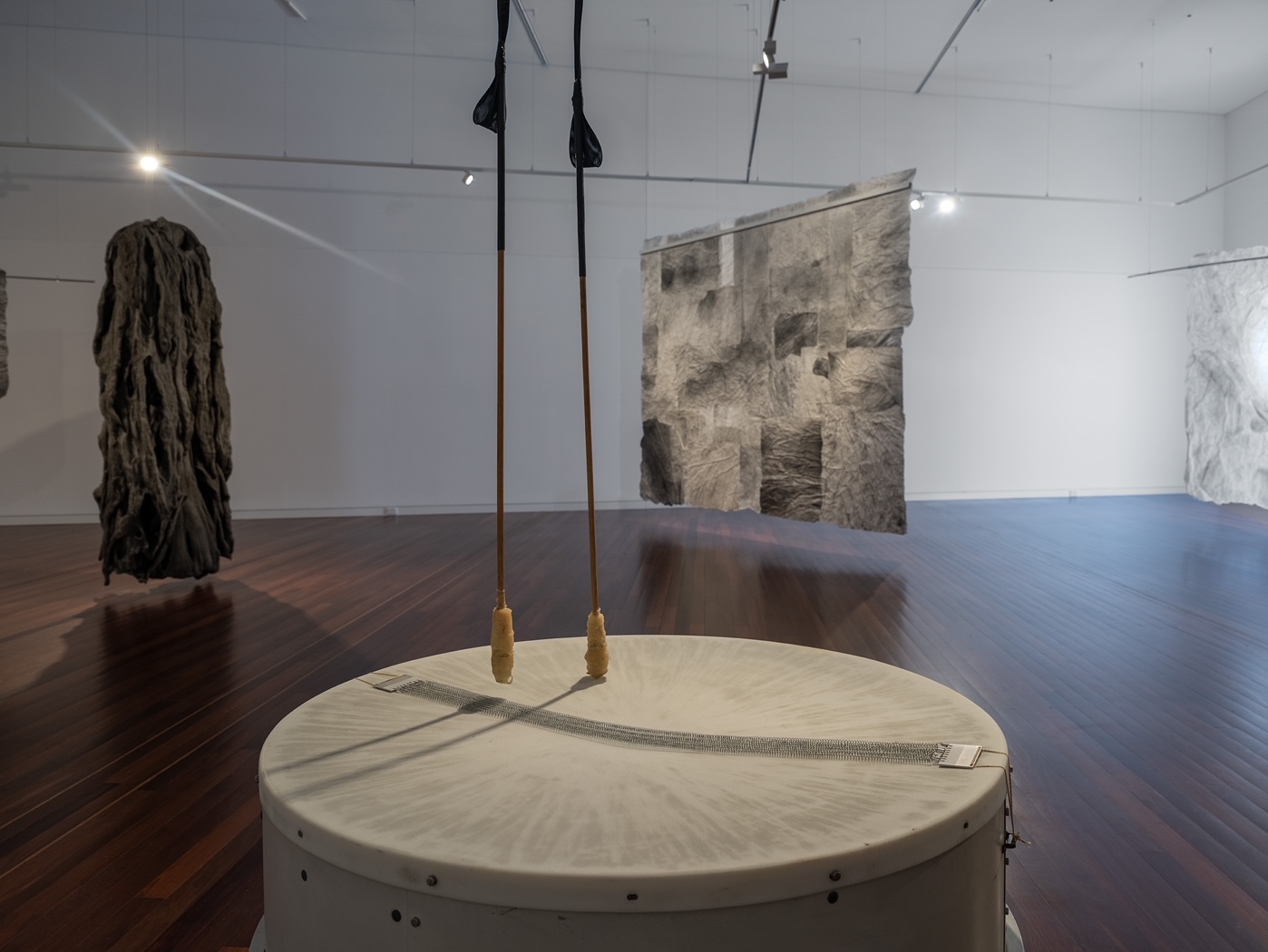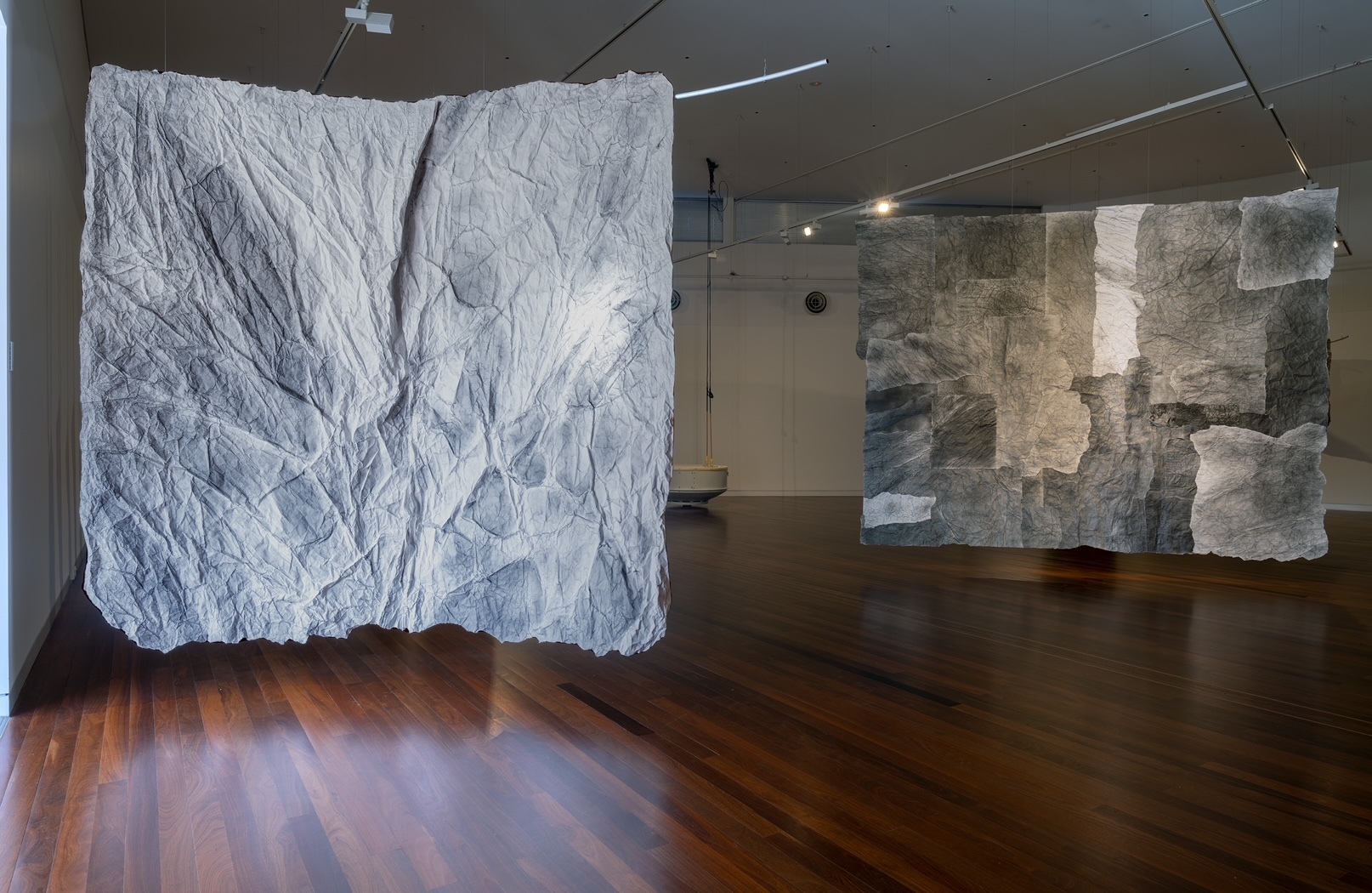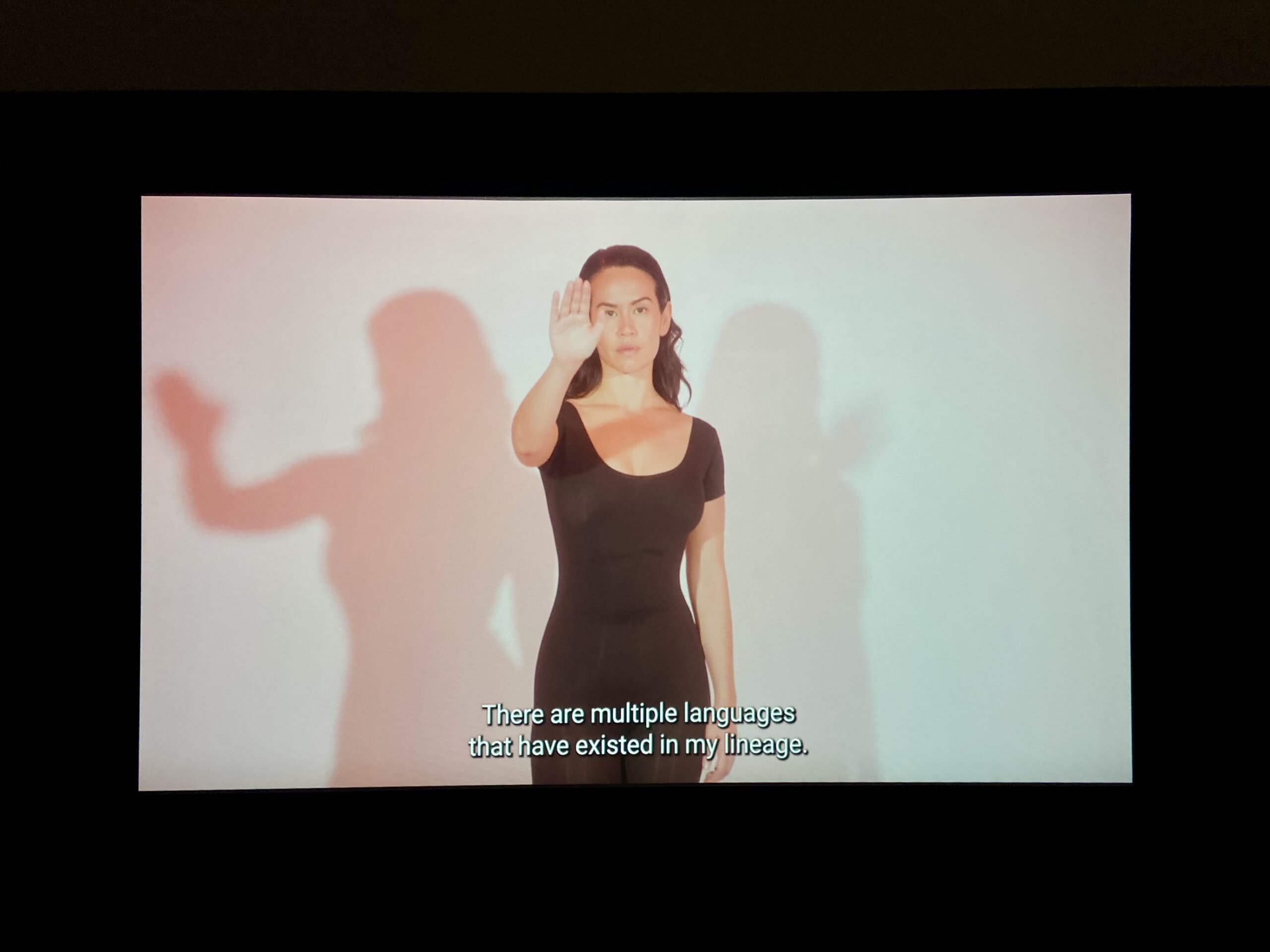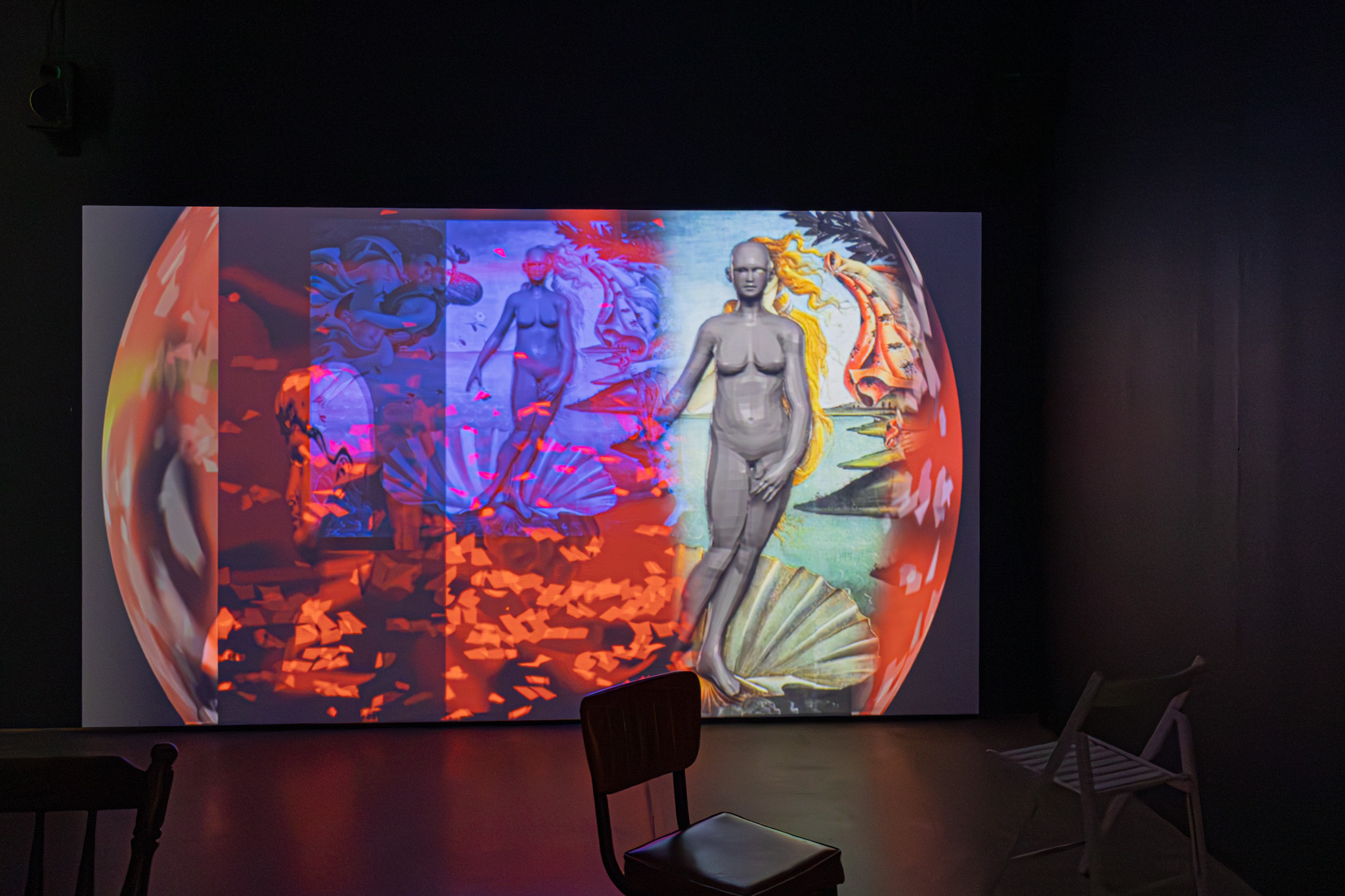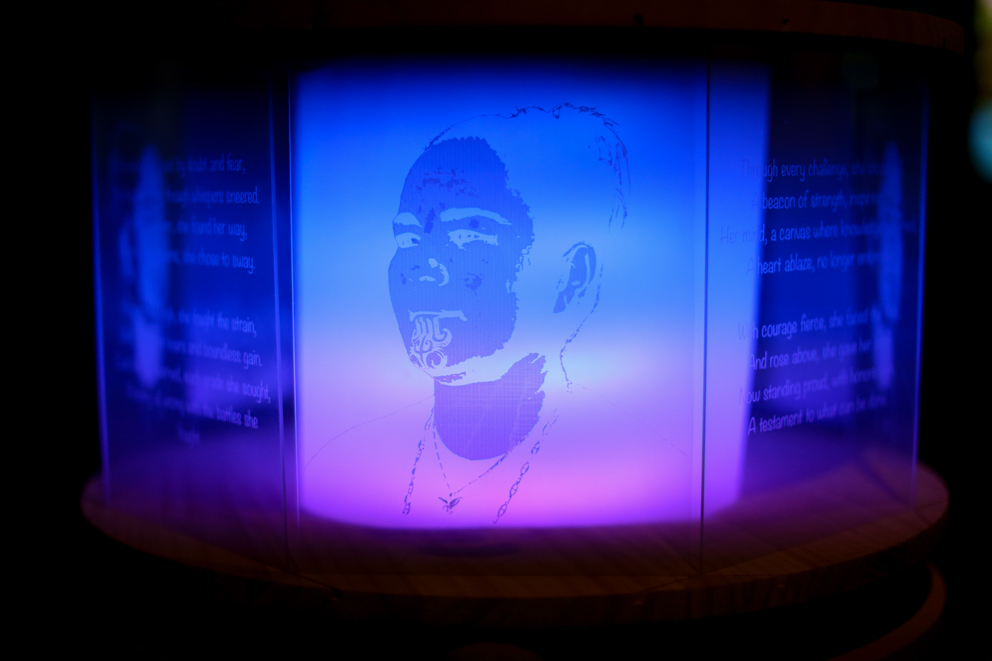Compositional Utterances is an elegant, restorative exhibition of drawing and sculpture that explores an aesthetics of friendship-based collaboration. Not many artists would (or could) develop such an exhibition, one that is the deeply felt outcome of numerous years of conversation, the exchange of ideas, and a shared affinity for probing into the expressiveness of matter and materiality. And while the works in the exhibition might seem to be straightforward, as a whole they initiate intimate, subtle correspondences, affirming that the three artists—Mandy Quadrio, Susan Hawkins, and Jan Oliver—are friends who have known one another for nearly a decade and “companioned together” as artists.[1]
Over time, the three artists realised they had formed strong bonds over their shared commitments to the natural environment, feminism, and investigating the interface between Indigenous and settler cultures.[2] Quadrio is a Trawlwoolway woman; Oliver and Hawkins are of European descent. Their complementary approach to materials, such as industrial found objects, steel wool, paper, and graphite, allowed each substance to speak with its own voice. Consequently, as these three artists worked to interrogate an aesthetics of relationality through their friendship, so too do their materials and finished works intra-act in their making, placement, and reception, as installed here. In Compositional Utterances, viewers are provoked in new ways to consider an ecology of the parts and the whole of the exhibition as each informs and relates to the other. This openness to the intra-action of bodies aspires to Indigenous critical studies scholar Aileen Moreton-Robinson’s identification of Indigenous being and knowing as, “embodied… [and] grounded within complex relations derived from the intersubstantiation of ancestral beings, humans and land, and carried by the body.”[3]
The potent pull of bodies is evident throughout the exhibition, most strongly in the traces of how the artists use their own bodies as they work. Going beyond the mark or gesture of the hand, evidence of their corporeal movement is encoded in surface, texture, shape and form; prompting us to imagine moving, hauling, pulling, shaping, cutting, un/crumpling, balancing, and ultimately configuring and hanging each work in the space. Their finished works evoke the body by cloaking (Quadrio), ensnaring (Hawkins), and locating (Oliver) corporeality.
Thus Quadrio’s Trumminyer (2023), a large rug formed from long, ragged lengths of abrasive steel wool, embodies the ghostly absence of its vanished wearer.[4] That person’s non-appearance is palpably sensed, yet mysteriously gone from the work.
Hawkins’ The Snare (2023)is fabricated from found telecommunications dishes, motors, timber, silicon, rubber bands, and cable sleeve. Here, two dishes, one twice as big as the other, have been converted into giant drums, complete with suspended, motorised drum sticks sounding against their surfaces—one stick in an inconsistent, staccato beat; two sticks rattling away like a snare drum. By playing the contrasting rhythms and timbres of one drum against the other, Hawkins fills the gallery space with a startling counterpoint of vibrations that seem to arbitrarily start and stop. While the sculpture’s title, The Snare, can be said to define the set of chains strung across the smaller drum to create a snarling sound, perhaps the title also implies a possession of the body’s corporeality, as waves of sound intermittently pulse through the gallery and viewers, heard but unseen.
Oliver’s series of very large crushed paper and applied graphite drawings are comprised of rough, tonal grey bumps, lines, furrows, bends, and creases. Their rebellious surfaces are not flat, and their edges meander irregularly. Suspended from the gallery ceiling, they allude to both micro and macro maps of earthly terrain, flowing water, fog, clouds, or magnified skin. But their overall effect is hard to pin down: they locate the viewer within smaller spaces of the gallery; they shift one’s spatial orientation toward a bird’s-eye point of view, and their endlessly morphing textural rhythms create surfaces that one would love to touch.
Each finished work relates as one body to another within the gallery space, and is sensed as simultaneously separate and together. This is due to the consummate installation realised by curator, Hamish Sawyer, in full consultation with the artists. As Sawyer explained, the manner in which the work is hung is a primary aspect of the artists’ concerns, and so he demurred to them during the hang. For instance, when Quadrio’s Trumminyer is viewed in alignment with Oliver’s Untitled (2023) (on the back wall of the gallery), the two form a textural and imagistic assemblage of the figure of an angel, or a giant moth. The metallic, raspy sound of Hawkins’ The Snare is not gentle: its insistent rhythms cut through our bodies, which inhabit the gallery, and across the eccentrically-shaped space, dissolving solids into a vibrating world. Oliver’s large-scale, cartographic graphite dustings on crumpled paper locate an ecological, environmental standpoint, or even internal bodily organs: lungs, kidneys, ovaries, hemispheres of the brain, and the symmetry/doubling of organic structures as in Untitled (2023), comprised of two separate drawings hung together. These works, which function both alone and in communion, engender community across a metaphorical spectrum of human and nonhuman, living and non-living. They seek to align with what ethnographer Deborah Bird Rose described for settler cultures as ‘shimmer,’ that is, an Australian Aboriginal aesthetic of kinship and care; a “commitment to bear witness to the shimmering, lively, powerful, interactive worlds… to engage in forms of passionate immersion in the lives of both humans and nonhumans.”[5]
The shimmer of material and poetic correspondences at work in Compositional Utterances emerges from the artists’ choice and use of materials, and from the intellectual and creative generosity that builds and weaves together the works, the exhibition, and the artists’ commitments to each other. This kind of thoughtful, caring, collaborative mix can be seen as intervening in the artworld’s excessively competitive and hierarchical forms of making and exhibiting. Or perhaps, it’s simply disruption in the shape of radical friendship.
Compositional Utterances tours to The Court House Gallery, Cairns, 12 January–4 March 2024; Presented by NorthSite Contemporary Arts in partnership with Cairns Regional Council.
[1] Mandy Quadrio, Susan Hawkins and Jan Oliver in conversation with Hamish Sawyer, Compositional Utterances, forthcoming exhibition catalogue (Sunshine Coast: UniSC, 2023).
[2] Quadrio is a Trawlwoolway woman; Oliver and Hawkins are of European descent.
[3] Aileen Moreton-Robinson as cited in Margaret Mutu, “Mana Māori motahake: Māori Concepts and Practices of Sovereignty,” in Aileen Moreton-Robinson, Linda Tuhiwai-Smith, Chris Andersen, Brendan Hokowhitu, Steve Larkin, eds., Routledge Handbook of Indigenous Critical Studies (New York: Routledge, 2021), 272.
[4] Trumminyer is the Trawlwoolway word for a wallaby-skin cloak.
[5] Deborah Bird Rose, “Shimmer: When All You Love is Being Trashed,” in Anna Lowenhaupt Tsing, Nils Bubandt, Elaine Gan, Heather Anne Swanson, eds., Arts of Living on a Damaged Planet: Ghosts and Monsters of the Anthropocene(Minneapolis: University of Minnesota Press, 2017), G52-G53.
Rose, who died in 2018, did long-term fieldwork with Ngaringman and Ngaliwurru communities at Yarralin, NT, beginning in 1980. In her life’s work she used aspects of anthropology, history, philosophy, cultural studies, religious studies, and animal studies; see Ann Standish, “Rose, Deborah Bird,” The Encyclopedia of Women & Leadership in Twentieth-Century Australia, https://www.womenaustralia.info/leaders/biogs/WLE0591b.htm
Carol Schwarzman is a visual artist and arts writer based in Meanjin/Brisbane. She is currently a PhD candidate at University of Queensland.


